| Author |
Message |
|
2CViking
viking bastard
Joined: April 18th, 2009, 11:43 am
Posts: 2424
Location: Meneac, Bretagne France

|
 Car preparation It is fairly easy to prepare your A-model for raiding. This section will cover the most important things to do. It is not bulletproof but it should allow you to do the raid without to many breakdowns. Still no matter how much you do, things are bound to fail or fall off. Main point is to prepare correctly and economically. Keep looking; this European winter is the right time to write this section. It will be based on previous raids mainly the Australian raids which are considered for some of the most difficult raids. This section is not open for debate. Feel free to discuss any preparation matters here. viewtopic.php?f=17&t=290
_________________

|
| October 6th, 2009, 6:46 pm |
 
|
 |
|
2CViking
viking bastard
Joined: April 18th, 2009, 11:43 am
Posts: 2424
Location: Meneac, Bretagne France

|
 Re: Car preparation Chassis To reinforce or not. Big question for many but not for me. My answer is no, why? If the 2cv has a good condition chassis and is not rotten on the inside, it can cope with at times the tuff treatment it’s given. Common sense is that an old rotten chassis can’t handle the stress during the raid and is most likely to collapse. Some raiders are of the opinion that ‘’if I reinforce the chassis, I can get through the raid no worries’’ yes and no. the combination or driving too heavy and fast is a sure recipe for disaster. All you need to do, is to make sure that the chassis is in good condition and that everything is bolted on to the chassis correctly. Make a ‘’bash-plate’’ and fit it under the engine from the front muffler to the front bumper. This will protect your engine and clutch for sand, stones etc. This one was made of aluminium and worked very well. Attachment:
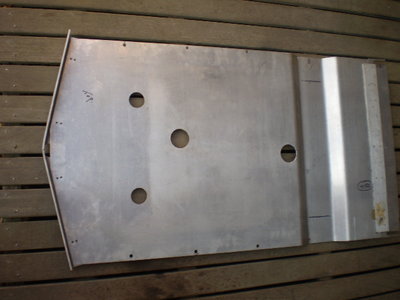 2cv repair trip 089.jpg [ 141.53 KiB | Viewed 10733 times ]
2cv repair trip 089.jpg [ 141.53 KiB | Viewed 10733 times ]
_________________

|
| October 6th, 2009, 7:03 pm |
 
|
 |
|
joe_catchou
Firing on two.
Joined: August 4th, 2009, 6:44 pm
Posts: 223
Location: Antwerp-EUrope-Globe

|
 Re: Car preparation this one's we make for some tourag trail drivers front and back protects. they look nearly  
_________________

http://foto.zita.be/joe_catchou
|
| October 6th, 2009, 9:11 pm |
  
|
 |
|
2CViking
viking bastard
Joined: April 18th, 2009, 11:43 am
Posts: 2424
Location: Meneac, Bretagne France

|
 Re: Car preparation Fuel tank protection
Seen a few different designs. The bad ones touched the bottom of the tank only giving protection from dirt and sticks settling around the tank. If an object on solid ground (stones wood etc) hits right underneath the tank sender, the chock will just transfer straight through the cover plate and force the sender unit upwards. The important part is to have some space between the bottom of the tank and the cover plate. Problem is that small stones have a bad habit of jamming them self in that particular place. One way of overcoming that is to pack the space with foam keeping the stones away. Best is of cause not fitting any plate at all and drive accordingly to the terrain. Plastic tanks are much better than metal + have more fuel in them.
My choice is no plate but you need to take real care when crawling through the landscape.
_________________

|
| October 6th, 2009, 11:11 pm |
 
|
 |
|
2CViking
viking bastard
Joined: April 18th, 2009, 11:43 am
Posts: 2424
Location: Meneac, Bretagne France

|
 Re: Car preparation How to inspect the chassis. 2CV chassis are very good at hiding the rust. They are rusting from the inside and out, sometimes with no visible signs. It can be very stressful to bend a chassis in the middle of nowhere and think that the car will be abandon. That is not going to happen. Check the chassis all over in particular here for a ripple. The side rail should be straight flat running your fingers along side the chassis. If you find a ripple don’t reinforce the side section. It simply can’t cope and is very likely to collapse during the raid. Fit a new good quality chassis and all your worries are gone. Attachment:
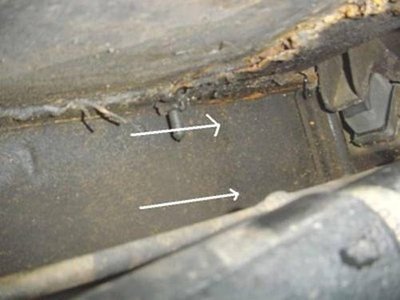 Chassis.JPG [ 72.46 KiB | Viewed 10674 times ]
Chassis.JPG [ 72.46 KiB | Viewed 10674 times ]
If you see a gap here, the chassis is ''KAPUT'' Attachment:
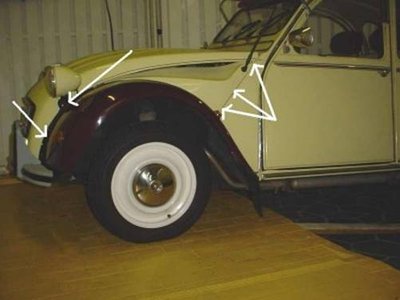 Chassis 1.JPG [ 64.86 KiB | Viewed 10674 times ]
Chassis 1.JPG [ 64.86 KiB | Viewed 10674 times ]
_________________

|
| October 7th, 2009, 6:06 pm |
 
|
 |
|
Hildebrandt
Firing on two.
Joined: May 3rd, 2009, 9:26 am
Posts: 107

|
 About reinforcements Viking and I have different political ideas about whether you chance your car, or not.
To me the 2CV represent a basic car meaning that you build on as you want the car to be.
I am fascinated by all kinds of special build-up cars, specially if they are made for travelling but also for a lot of other purposes.
I am a do it your self type and I would prefer personally to fabricate all parts for my car. Inspired by the 2CV but each part made to fit the purpose that I intend for this 2CV.
This is said to make it clear that I wont be in opposition to people who does the same.
Anyway Peter and I write this tread to make it clear what you need to do to get a car ready to complete this desert piste/off-road raid.
This will be based on travelling light.
If you want to carry more weight than the car is designed for, a lot of new problems starts – of course it is possible to make a 2CV carry more. The AK, Ami and Méhari 4X4 are examples to that.
These cars has been chanced in all parts of the chassis and axles -not that big chances, but important ones.
Very often reinforcements are made in a way so that they create new problems if not by weakening the construction, then simply by adding extra weight to solve a none existing problem.
Many have seen photos off cars that has broken in different ways, therefore they want to reinforce their car.
If the car broke down because of driving on corrugation. You should know that reinforcements might chance the speed that you can be driving with without starting to shiver and vibrate violent all over.
But it can never make your car withstand these vibrations in the long run.
Lowering the tyre pressure can help a little but first of all, it is up to the driver to avoid these vibrations by going at the right speed.
´
So the advise is don't reinforce because of corrugations. Check the bolts often, not by tightening them further since the bolt will be stressed, just check if they are loose.
If the car has bended the chassis or parts of the suspension arms, it is usually because of hitting holes or stones in a wrong angle.
The impact of a loaded 2CV driving only10 km/h is more than 3 ton - if you are going with 15 km/h it is almost 7½ ton - rein-forcing to make the chassis take that kind of impact takes a lot of steel.
So drive carefully - and if some thing like that happens, pray to that we together can make your 2cv run again.
This raid wont be a race. We want to travel slowly and peace-full through the rough terrain.
Getting stuck or coming later is not a problem- damaging your car is.
Attachments:
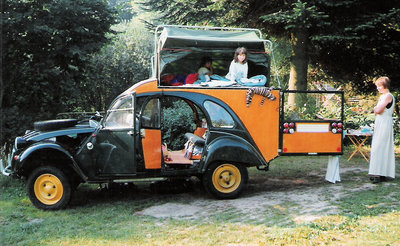 scan0023.jpg [ 221.06 KiB | Viewed 10648 times ]
scan0023.jpg [ 221.06 KiB | Viewed 10648 times ]
_________________
Best regards,
Ulrik
2cv.Clinikken
Denmark
|
| October 8th, 2009, 4:14 pm |

|
 |
|
Hildebrandt
Firing on two.
Joined: May 3rd, 2009, 9:26 am
Posts: 107

|
 Improvement of off-road capabilities When planing this raid it is our aim, that we should find some of the most difficult roads to travel along.
Roads in the Sahara might start up as a quite OK unsurfaced track, but after a shorter or longer time you may find it difficult to find the track at all, you will find yourself crossing dried out rivers and that can be a task including quite difficult off road driving, sometimes you might have to give up and go further up hill searching for a place with less steep banks.
A 2cv has thanks to its: low weight, low ratio 1. gear and the interaction-system, that allows big independent wheel travel, and (compared to the weight) big wheels, very good off road capabilities.
Meaning that you can pass difficult places rather slowly meaning less risk for damage.
You can improve this by raising the ground-clearance to maximum allowed for a Méhari. Remember to adjust the bump-stops at the same time.
Bigger ground clearance and raised bump-stops also reduces the risk of hitting stones and bending the chassis, if you go to fast-
But you are in the desert and you shouldn't go to fast.
Quitting the front and rear bumpers improves your attack and departure angel. Plus it saves weight+++
A front-buffer with a steel or ALU sheet-metal bending up to the bonnet may help you not getting to much dirt and water into the fan
Tube type bumper like the old P.O. type front bumper are god even though some of the latest were made with a tube that was a bit to weak to use for lifting the car. Be sure to fit it at as high as posible.
This bumper is lighter and much better (stiffer) bolted to the chassis than the standard ones.
Those bumpers sold in the 80. as safari-bumpers are in my opinion to heavy and not proper bolted to the chassis + it reduces your attack-angle,
Don't use to heavy materials if you decide to build and use bumpers.
The interaction should always be kept since it takes a lot of twisting away from the chassis. It is important that there is the right space to the rubber for the interaction-system. This is also very important for off-road driving capabilities - specially when loaded.
Knife-edges and tie-rod ends are important parts of the suspension. They should be checked care-fully for cracks and wear. It is a knife edge- not a plain bearing, if they are worn so that the knife-edge has a saddle to rest in it gives a constant bending of the tie-rods- and one of the parts might brake down, greasing them wont help if they are worn.
The use of bigger (145 and +) tyres does give even more ground clearance. But except for that, and perhaps a better M+S pattern that at some surfaces improves the grip, it won't improve your off road capabilities.
Though bigger tyres allows you to go with at lower pressure without heating and damaging the tyre.Bigger tyres protects your rims better specially when driving with low pressure in areas with both sand and rocks.
But bigger tyres can't guaranty you from damaging a rim.
Heavier wheels adds more stress to the shock absorbers.
The low pressure is a must in sandy condition and it helps a bit on corrugations.
But you can lower the pressure to almost the same level if using 135 tyres. You will just have to be more care full not hitting rocks and to keep your speed low.
Remember You are in the desert so you should drive care full anyway.
If you are going to chance your gearbox.
Using one of the gearboxes that has a short 1. gear. Gives you more power at low speed and can help you to keep the foot away from the clutch.
Personally I would not take of with the gearbox from an Ami, since it has a very long 1. gear.
You can off course add diff lock and 4 wheel drive. This can radically improve your off-road capability. Anyway it would be really hard to say that it is necessary having in mind what 2CV's over the years has manèged to get through.
This said, I will be testing my own diff lock at our raid and I would love to see A four-wheel driven 2CV operate in the dunes.
Attachments:
File comment: interaction in action - no need for diff-lock
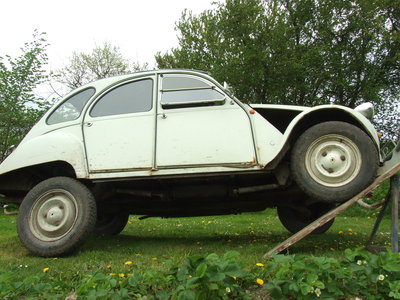 DSCF4784.JPG [ 3.1 MiB | Viewed 10634 times ]
DSCF4784.JPG [ 3.1 MiB | Viewed 10634 times ]
_________________
Best regards,
Ulrik
2cv.Clinikken
Denmark
|
| October 8th, 2009, 7:26 pm |

|
 |
|
2CViking
viking bastard
Joined: April 18th, 2009, 11:43 am
Posts: 2424
Location: Meneac, Bretagne France

|
 Gear box What to do on the gear box. Being bogged in sand is a potential recipe for disaster. It is very important to lock the selector ring on 2nd/3rd sliding pinion and to tie the 2 rear nuts behind the rear cover. If you don’t know how to, have it done by someone in the know. Apart from that, look at your gear box mount, boot on the gear lever and the 2 rubbers on the lever joint. Sand is a perfect killer of all metal, best kept away from the gear box. Make sure that the bash plate underneath doesn’t allow sand reaching the gear box and in particular the clutch. Add fresh gear oil and bring same oil just in case you need to drop the oil. Attachment:
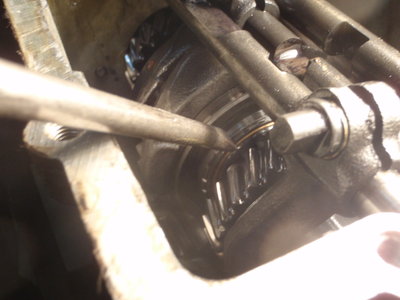 P6110466.JPG [ 229.55 KiB | Viewed 10447 times ]
P6110466.JPG [ 229.55 KiB | Viewed 10447 times ]
Attachment:
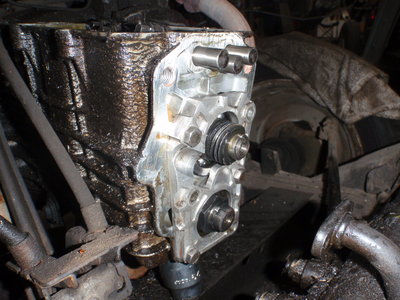 P6110469.JPG [ 307.68 KiB | Viewed 10447 times ]
P6110469.JPG [ 307.68 KiB | Viewed 10447 times ]
_________________

|
| September 24th, 2010, 9:14 pm |
 
|
 |
|
2CViking
viking bastard
Joined: April 18th, 2009, 11:43 am
Posts: 2424
Location: Meneac, Bretagne France

|
 Tyres The choice of tyres is a hot potato. We have seen the entire range of tyres on raids with mixed results.
Standard Michelin 125/15 is perfect for asphalt roads. Not recommended for off road conditions. The side wall is simply not strong enough to cope with the rocky conditions. However we see again and again, raid cars completing raids on such tyres…!!!
My recommendations are to fit 135/15 MS or 145/15 tyres, bigger is not necessary. Start off with tubeless and fit tubes if you puncture. Tyre pressure is also debatable, but 12/15 psi in sand and on corrugated road will give a smoother ride.
_________________

|
| September 24th, 2010, 9:27 pm |
 
|
 |
|
2CViking
viking bastard
Joined: April 18th, 2009, 11:43 am
Posts: 2424
Location: Meneac, Bretagne France

|
 Engine A complete engine service is recommended before the raid. Start with a compression test, this will give you a picture of the inside condition of your pistons, barrels and compression chamber. It should read from minimum 100 psi up to 160 psi with max. 10% variation. If more than 10% variation or low compression, it is worth removing the head(s) to investigate. If no problems remove the valves covers and check the 3 main nuts holding the cylinder heads. Some cars are “farting” due to compression escaping between the cylinder head and cylinder. Adjust the valves to 0.20 mm and fit new valve cover seals.
Fit new contact points/condenser set, sparkplugs and sparkplug leads. If electronic ignition is fitted, bring a complete original Citroën contact points/condenser set including the box, advance weights and all other fitting, if you need to convert back to contact points. If the electronic ignition becomes faulty, your spare points will keep you moving. Old coils are bad news, bring a spare or change it before leaving home.
Clean the oil cooler, it’s usually clogged with old oil and dirt. Reduced airflow through the oil cooler can lead to overheating. Inspect the oil feeding tube on the engine and on both cylinder heads for rust and oil leaks. Fit new engine mounts; inspect the fan hub for cracks around the factory welding, if any cracks replace the fan hub.
Inspect the fan protective grill for defects and make sure the light grill mesh on the inside of the bonnet is firmly secured to reduce the risk of stones and twigs entering the fan cooling shield.
Change oil and filter, bring extra oil and filter for a complete change during or after the Raid.
_________________

|
| September 24th, 2010, 9:40 pm |
 
|
|
Who is online |
Users browsing this forum: No registered users and 5 guests |
|
You cannot post new topics in this forum
You cannot reply to topics in this forum
You cannot edit your posts in this forum
You cannot delete your posts in this forum
You cannot post attachments in this forum
|

|

